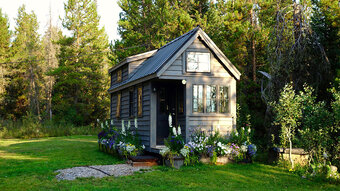Harris, Reed & Seiferth
|
 It's so easy to get wrapped up in the notion that "bigger is better." Contentment always seems to be tragically unreachable whenever cravings for more and more consume us. We want more so-called "friends" on social media. We want more closet space for an ever-growing pile of clothing that we rarely wear. "Why yes, I'd like to supersize my meal!" we chant in a frenzy at our favorite fast food joints. Our appetites never seem to be satisfied. OK, perhaps I'm making hasty generalizations and exaggerations, but we can all at least admit to occasionally being tangled in the chaos and busyness of life. Everyone has their own tedious tasks to take on and along with them come bills to pay, relationships to build and hours of sleep to never completely catch up on. Organizing, compartmentalizing and managing all of the overwhelming "stuff" that accumulates in life can make one weary and stressed. From this perspective it's easy to see why we have the tendency to think that more money, more space, more tools, more time — more everything — will help us solve all of our problems. However, there is a group who has found contentment in having less; satisfaction in the simple life; and freedom in letting go of materialistic burdens. These unique and inventive individuals are the ones who are driving the rising tiny house movement. The tiny house movement refers to the social and architectural movement that encourages living simply, efficiently and sustainably in small homes. Just how tiny are these homes? Typically containing a living area, sleeping loft, kitchen and bathroom, these homes rarely exceed 400 square feet. Some of them are built on permanent foundations, but many of them are on wheels and are easily portable. Architect and author, Susan Susanka, is often credited with starting the movement in 1997 when she published The Not So Big House. Since then, the idea that bigger doesn't always equal better in home building has continued to grow. There are many strong advocates for the movement, like Jay Shafer, who founded the Tumbleweed Tiny House Company. Schafer's manufacturing company builds customized tiny houses and ships them to customers who are eager to pursue a simplified lifestyle. In an interview with Shareable, Schafer explains that the movement is about people not wanting to consume more than they have to. "It boils down to efficiency," he remarks. When asked about what qualifies a home as part of the tiny house movement, he states, "Any house in which all the space is being used well." Indeed, the idea of living an efficient, self-sufficient and simplified lifestyle has attracted many to the movement. The appeal of environmental consciousness is also a large contributing factor: tiny houses require much less energy and greatly reduce one's ecological impact. Lastly, tiny houses are much less expensive when it comes to building, heating and maintenance, so the more economically-balanced lifestyle that is offered through tiny house living is more than enough to draw interest. Tiny houses are capturing the attention of the public and, for many, are becoming a legitimate housing alternative. The movement is gaining increased media coverage. TV shows like Tiny House Nation, Tiny House Builders and Tiny House Hunters celebrate the exploding movement by offering building tips and spotlighting unique tiny houses and their owners. In addition, nonprofits like the American Tiny House Association and groups like the Tiny House Community are working to promote the tiny house as a formally acceptable dwelling option and are sponsoring workshops, fairs and conferences that bring together builders and enthusiasts. Online communities like Living Big in a Tiny House, Small House Society, The Tiny Life and Tiny Home Builders create opportunities for people to connect and share advice and stories from their tiny house lifestyles. Though living in a tiny house may not be for everyone, there is definitely something we all can learn from the movement. Learning to share, adapting more efficient and sustainable practices and choosing to live freely and fully by slowing down and taking the time to refocus on what's truly important in life are certainly all commendable endeavors. Foremost offers solutions for insuring tiny houses. If the unit is on permanent foundation and attached to permanent facilities, it is eligible for a Dwelling Fire or Specialty Homeowners policy. If the unit is RVIA approved, with the wheels still intact, it is eligible for a Travel Trailer policy. Source: https://www.foremost.com/learning-center/Understanding-the-Tiny-House-Takeover.asp
0 Comments
Leave a Reply. |
Categories
All
Archives
May 2024
|
Social MediaContact UsNavigation |
|
Website by InsuranceSplash
Privacy Policy | Terms of Use
© 2025 by HARRIS, REED & SEIFERTH INSURANCE GROUP, INC. All rights reserved.
© 2025 by HARRIS, REED & SEIFERTH INSURANCE GROUP, INC. All rights reserved.

 RSS Feed
RSS Feed